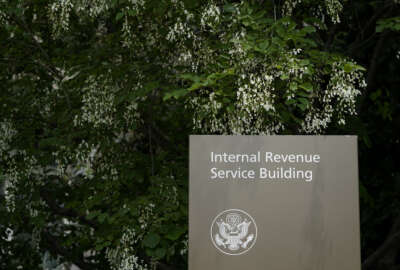IRS struggles to process suspended returns with errors and update taxpayers
If citizens can't escape death and taxes, the IRS can't seem to avoid yearly processing problems. Even as the this year's filing season ended, the IRS was dealing...
Best listening experience is on Chrome, Firefox or Safari. Subscribe to Federal Drive’s daily audio interviews on Apple Podcasts or PodcastOne.
If citizens can’t escape death and taxes, the IRS can’t seem to avoid yearly processing problems. Even as the this year’s filing season ended, the IRS was dealing with millions of returns from last year, to say nothing of slow call centers and poor in-person service. For the view of the Government Accountability Office, the Federal Drive with Tom Temin turned to the Director of Strategic Issues Jessica Lucas-Judy.
Interview transcript:
Tom Temin: Ms. Lucas-Judy, good to have you back.
Jessica Lucas-Judy: Thanks for having me.
Tom Temin: And, again, the IRS seems to be this déjà vu situation? What is their current status with respect to the backlog leftover from last year? And what are the things look like as they start to digest what they’re taking in for this year?
Jessica Lucas-Judy: Well, as we reported going into the 2021 filing season, so last year, IRS had a backlog of about 8 million unprocessed returns from 2020. They were gradually able to work through that backlog and catch up but then ran into the same problem going into this filing season as at the end of 2021, they had about 10.5 million returns from 2021 that had not been fully processed, and had to deal with those still, while the 2022 filing season was beginning.
Tom Temin: Got it. And do we have any idea at this point yet, how many paper returns have come in for the most recent filing season that ended earlier this month?
Jessica Lucas-Judy: Well, overall, most taxpayers do still file electronically, especially individual taxpayers, that percentage is up over 90% and has stayed pretty steady. So for most taxpayers, if you file electronically, you have a pretty simple return, there are no problems. If you’re owed a refund and you choose electronic deposit, you’ll get it pretty quickly. Where IRS was running into difficulty was with the returns that were suspended or stopped due to errors. And what we found last year with 2021 was that the number of returns that were suspended due to errors just went up by quite a lot. And that was causing delays in taxpayers getting the returns processed and getting the refunds paid. And that just sort of snowballed. You know, as people are trying to find the status of their return and their refund, they’re calling, they can’t get through, maybe they would send a letter, or they would think they needed to file a second copy of their return. So then there’s correspondence that’s piling up, they will go to the website and not be able to get enough information their IRS was trying to direct people to its online tool, Where’s My Refund. But the problem that we found there is Where’s My Refund does not really provide sufficient information for a taxpayer to know what happened to their return. So it just had some basic information, you know, that your return had been received, and then it was processing, and then eventually it would tell you that the refund had been issued. But if your return was stuck somewhere, all you got was processing. And that went on sometimes for weeks and weeks and weeks for some taxpayers, then the cycle would start again and the taxpayer would try calling, they would send a letter, they would send another copy of their return. And so the IRS just got more and more and more behind. So we made recommendations that IRS have a plan in place to modernize Where’s My Refund, that it tried to figure out the reasons for the volume of returns that were being stopped due to errors and tried to see if there were going to be some recurring errors, maybe try to address some of those.
Tom Temin: We’re talking mainly about the paper returns here, correct?
Jessica Lucas-Judy: Both paper and electronic actually, paper had even more delays, that always takes longer. It’s a manual process. If you file your return on paper, somebody then has to open it, has to process it, someone has to manually enter the data into IRS systems, then somebody else has to review it. And if you’re owed a refund, you know, issue that refund.
Tom Temin: Sure, but for the paper returns that do come in at least they get logged as they come in so that they have some electronic representation. And that’s how the IRS is at least marginally able to tell people what’s going on with them?
Jessica Lucas-Judy: Right. And what was happening last year was from 2020, still, there was such a backlog of paper returns and other correspondence that they hadn’t been able to process when the pandemic first hit. And they had to shut down the processing centers and stop dealing with the mail that was all piling up. So it took IRS quite a while to be able to work through that backlog. And they do everything is a first in first out then if they were still dealing with correspondence and returns from 2020, the 2021 mail was coming in that was further behind in the queue. And so even though it was received, it would be a while before somebody could process it. And so that was certainly taking time as well.
Tom Temin: We’re speaking with Jessica Lucas-Judy, she is the director of strategic issues at the Government Accountability Office. Is this whole pandemic and workforce remote and can’t get to the mail related what’s going on because it seemed like it was the pandemic that caused the initial delays?
Jessica Lucas-Judy: Well, this is something that IRS has been challenged with for a number of years. But the pandemic certainly exacerbated problems that were there already. Paper really has been a problem for the IRS, a lot of its processes are manual. And especially when you’re dealing with paper returns, there are some returns and some schedules that can only be submitted on paper. And then you have some business and individual taxpayers who choose to submit on paper. And then a lot of the correspondence with IRS is also on paper. So all that paper, it adds up, and people have to deal with it, and you have to deal with it in person. And so that had been problem even before the pandemic, but then when the pandemic shut things down, it took a while to try to resolve that backlog.
Tom Temin: And would you recommend that the IRS modernize its Where’s My Refund program? That’s a short phrase, but it seems like a heck of a big job.
Jessica Lucas-Judy: It is. It is. It’s one of many system and processes that the IRS has on its list of things that they would like to do as a project for modernization. But we were unable to get information on sort of, you know, what the actual plan was for modernizing Where’s My Refund. What was the timeline? What was the budget? And so that’s what we were recommending that IRS do.
Tom Temin: And what’s the IRS telling you, it seems like they’re in the situation where everyone’s trying to fatten the pig by weighing it. They’ve got the inspector general for tax administration, the IRS, the TIGTA group looking at them, they’ve got you looking at them, they’ve got lots of external groups, looking at them. Seems like a pressure cooker over there.
Jessica Lucas-Judy: Right. And there certainly is a lot of interest in this particular topic. But as I said, you know, the IRS did manage to make some improvements, even without a full scale plan for modernizing Where’s My Refund. They were able to make some tweaks to the tool in the system to provide some more information to taxpayers, which hopefully has helped with this current filing season. But it’s still not a substitute for an overall modernization. I mean, the tool hasn’t been modernized in about 20 years,.
Tom Temin: Right. And the tool itself would not speed up processing necessarily, and especially dealing with paper—
Jessica Lucas-Judy: Correct.
Tom Temin: —it would simply give more accurate accounts to people about where their return is in the queue.
Jessica Lucas-Judy: Right, which cuts down a lot on taxpayer frustration and confusion. And also, because so much of this is interrelated, might help cut down on the number of phone calls to IRS, the amount of correspondence to IRS, if people have a better idea of where their tax return is, where their refund is.
Tom Temin: Sure. And as you mentioned earlier, it would maybe cut down on the number of repeat copies of returns that people send in. That’s got to add to the confusion.
Jessica Lucas-Judy: Exactly.
Tom Temin: And what does IRS say? Yeah, sure, well modernize it.
Jessica Lucas-Judy: Well as with many things, it’s contingent on funding, it’ll be important for IRS to work with Treasury and to be in close communication with Congress to be able to have that plan developed and to have a good idea of what kind of funding investment it’s going to take.
Tom Temin: Right so that there’s a good request in from the administration for 2023 fiscal year. But we’re months who knows how long from those appropriations actually coming through.
Jessica Lucas-Judy: Right. And it’s one of only many things that the IRS is trying to tackle, they’ve had to modernize their telephone system. One of the things that they’re trying to expand and that they have been expanding is a callback feature for customers, there are very long hold times when you call the IRS and it takes a while to get through. And so one option that’s available on some of the IRS phone lines now is just as you know, when you call your bank or some other entity, if there’s a wait, it can tell you what the estimated wait time is and offer to call you back when it’s your turn. And so that’s something that the IRS has been expanding, but it had to upgrade its phone system to be able to handle that.
Tom Temin: And then again, if they tell you when they’re going to call back, it’s still not sufficient to say yeah, we’ll call you back the day after Christmas.
Jessica Lucas-Judy: Right, right. It’s an alternative to having to be on hold. But again, you know, something that can be a little bit more convenient for taxpayers, so they can at least do something else while they’re waiting for the IRS.
But another challenge then is you still only have a certain number of assisters who are available to take those calls. So that’s another challenge the IRS has had in staffing and hiring and making sure that it has sufficient staff particularly in this current job market. So they’ve been doing surge hiring, they recently got expanded authority to be able to bring people on board a little bit more easily. They’ve been holding job fairs, and trying to get people on board. But they still have to train them and get them in the door before that can really help.
Tom Temin: Yeah, the work that they do is particular and difficult and sometimes really arcane because of the depth of the tax laws. And so just hiring people is only the beginning of getting them productive.
Jessica Lucas-Judy: Exactly. They’ve also been relying on recent retirees or others who have left the service and to bring them back on a temporary basis because they don’t require as much training if any training at all to be able to help out and they’re moving people within IRS from some other functions to be able to do things like answer the phones, deal with the correspondence, process the returns and otherwise try to manage the backlog. The commissioner has said that he wants all the backlog dealt with by the end of this calendar year.
Tom Temin: Jessica Lucas-Judy is director of strategic issues at the Government Accountability Office. Thanks so much for joining me.
Jessica Lucas-Judy: I really appreciate it. Thanks so much.
Copyright © 2024 Federal News Network. All rights reserved. This website is not intended for users located within the European Economic Area.
Tom Temin is host of the Federal Drive and has been providing insight on federal technology and management issues for more than 30 years.
Follow @tteminWFED






